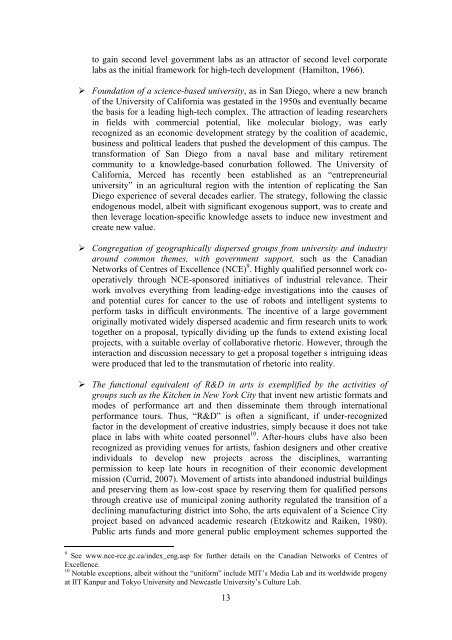A Triple Helix System for Knowledge-based Regional Development ...
A Triple Helix System for Knowledge-based Regional Development ...
A Triple Helix System for Knowledge-based Regional Development ...
- No tags were found...
You also want an ePaper? Increase the reach of your titles
YUMPU automatically turns print PDFs into web optimized ePapers that Google loves.
to gain second level government labs as an attractor of second level corporatelabs as the initial framework <strong>for</strong> high-tech development (Hamilton, 1966).‣ Foundation of a science-<strong>based</strong> university, as in San Diego, where a new branchof the University of Cali<strong>for</strong>nia was gestated in the 1950s and eventually becamethe basis <strong>for</strong> a leading high-tech complex. The attraction of leading researchersin fields with commercial potential, like molecular biology, was earlyrecognized as an economic development strategy by the coalition of academic,business and political leaders that pushed the development of this campus. Thetrans<strong>for</strong>mation of San Diego from a naval base and military retirementcommunity to a knowledge-<strong>based</strong> conurbation followed. The University ofCali<strong>for</strong>nia, Merced has recently been established as an “entrepreneurialuniversity” in an agricultural region with the intention of replicating the SanDiego experience of several decades earlier. The strategy, following the classicendogenous model, albeit with significant exogenous support, was to create andthen leverage location-specific knowledge assets to induce new investment andcreate new value.‣ Congregation of geographically dispersed groups from university and industryaround common themes, with government support, such as the CanadianNetworks of Centres of Excellence (NCE) 9 . Highly qualified personnel work cooperativelythrough NCE-sponsored initiatives of industrial relevance. Theirwork involves everything from leading-edge investigations into the causes ofand potential cures <strong>for</strong> cancer to the use of robots and intelligent systems toper<strong>for</strong>m tasks in difficult environments. The incentive of a large governmentoriginally motivated widely dispersed academic and firm research units to worktogether on a proposal, typically dividing up the funds to extend existing localprojects, with a suitable overlay of collaborative rhetoric. However, through theinteraction and discussion necessary to get a proposal together s intriguing ideaswere produced that led to the transmutation of rhetoric into reality.‣ The functional equivalent of R&D in arts is exemplified by the activities ofgroups such as the Kitchen in New York City that invent new artistic <strong>for</strong>mats andmodes of per<strong>for</strong>mance art and then disseminate them through internationalper<strong>for</strong>mance tours. Thus, “R&D” is often a significant, if under-recognizedfactor in the development of creative industries, simply because it does not takeplace in labs with white coated personnel 10 . After-hours clubs have also beenrecognized as providing venues <strong>for</strong> artists, fashion designers and other creativeindividuals to develop new projects across the disciplines, warrantingpermission to keep late hours in recognition of their economic developmentmission (Currid, 2007). Movement of artists into abandoned industrial buildingsand preserving them as low-cost space by reserving them <strong>for</strong> qualified personsthrough creative use of municipal zoning authority regulated the transition of adeclining manufacturing district into Soho, the arts equivalent of a Science Cityproject <strong>based</strong> on advanced academic research (Etzkowitz and Raiken, 1980).Public arts funds and more general public employment schemes supported the9 See www.nce-rce.gc.ca/index_eng.asp <strong>for</strong> further details on the Canadian Networks of Centres ofExcellence.10 Notable exceptions, albeit without the “uni<strong>for</strong>m” include MIT’s Media Lab and its worldwide progenyat IIT Kanpur and Tokyo University and Newcastle University’s Culture Lab.13










